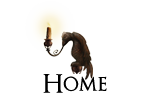Scribble City Central's eighth Fantabulous Friday comes from John Dougherty, author of (among many other wonderful titles) the Bansi O' Hara books. I'm always a sucker for Irish myths, and John has taken many elements from them here and woven his characters into two magically funny and exciting plots.
I absolutely loved these books (and secretly hope I can be Mrs Nora Maura Margaret Mullarkey when I grow up). Bansi herself is feisty, engaging and brave - all things I require in a heroine - and the double act of Tam and Pogo charmed the socks off me and made me laugh. I'm ashamed to say that I didn't know much about Cluricauns, so Flooter was a bit of a revelation to me. I'm delighted that John chose this particular being to write about - one of the pleasures of this series for me is that it's turning out to be an education for me as well as my lovely blog readers. I will therefore pass you over to John to tell you about:
C for Cluricaun
Haunter of Cellars
JD: One of the great shames of growing up in Northern Ireland in the 1960s-1980s was the way that everything cultural was politicised.
The effect of this on even fairly apolitical children like myself was enormous. I remember being told precisely one Irish folk tale during my entire schooling - that of Finn MacCool and the Giantʼs Causeway - and a couple of fairly innocuous folk songs managed to sneak their way into music lessons, but really that was about it. Any attempt beyond that to connect us with the folklore and traditions of Ireland would have been seen, in my home town at least, as tantamount to encouraging us to don balaclavas and bomb innocent people out of house and home.
As a result, the only creature from Irish legend I could identify - apart from the mighty Finn himself - was the leprechaun, or rather the horribly twee version of him beloved by cynical Tourist Boards, which came to typify for me all that was ghastly about stage and screen Oirishness (see Tommy Steele in Finianʼs Rainbow for a particularly gruesome example).
As I grew, though, and especially after my move to England in my early twenties, I became more and more aware of my own Irishness, and of an ancient culture of which that blooming leprechaun was at best an incredibly clumsy caricature. And as I began to experiment with writing for children, I began to want to write something with at least some reference to that culture.
The first half-finished draft of the story that was to become Bansi OʼHara and the Bloodline Prophecy played around with this idea. It included sly references to stories Iʼd begun to discover, such as The Children of Lir, and to ideas from Celtic mythology that had their parallels in other cultures, like skin-changers. But there were also, in that first draft, great big holes in the plot, and characterisation issues, and I put it aside for a few years, always meaning to come back to it.
When I eventually did, I switched the characters of Fionnula and Aed - named after two of Lirʼs children, but whose propensity for turning into swans was entirely voluntary - for a brownie (borrowed from Scots & English folklore) and a púca (very definitely Irish), ditched an extraneous character, and sent Bansi off on her adventures. And then came the point at which Pogo, the brownie, and Tam, the púca, lost Bansi and had a furious row about it, and I needed another character to defuse the situation and perhaps add a bit of light relief.
This was when the cluricaun first properly entered my life. The word had already caught my eye amidst the long lists of faery creatures Iʼd come across, largely because of its similarity to the name of the Cluracan, one of the cast of characters in Neil Gaimanʼs Sandman series, itself probably something of an influence on Bansiʼs world.
What appealed to me most was the cluricaunʼs reputation for drunkenness. Theyʼre always drunk. Itʼs their defining characteristic. In fact, some sources reckon the cluricaun is just a leprechaun on a bender after work - but not in my story, he wasnʼt. I even consciously went for the spelling without the ʻhʼ (it can also be rendered ʻclurichaunʼ) just to avoid any confusion with the green-jacketed little stereotype.
I was also drawn to what I saw as a devil-may-care attitude. The cluricaun is likely to hijack a dog or even a sheep, leap on its back, and go off for a wild and drunken ride in the moonlight. Iʼve known people with that sort of attitude, and frequently theyʼre infuriating and charming in equal measure.
Legends being what they are, a number of different - and sometimes contradictory - descriptions of the cluricaun are available, and so I felt rather at liberty to pick and choose. I gave my cluricaun the red cap that some sources describe as distinguishing him from the leprechaun, and ignored any portrayal that gave him a green jacket, silver-buckled shoes, or any item of clothing that might make a Tourist Board official sit up and take notice. Some accounts have him as surly, others jolly; this I put down to individual differences, and decided that my cluricaun would be something of a cheerful comedy drunk. He was small, of course (everyone seemed to agree that a cluricaun is one of the Little People) and a red nose was a fairly commonly described feature - to which I added cheerfully red cheeks over a greyish complexion.
Generally speaking, the cluricaun is said to occupy wine cellars - guarding them if youʼre good, drinking or spoiling them if youʼre not. There werenʼt any wine cellars in the story, but I managed to work in a sarcastic reference to them from Pogo, who at last agrees to continue working with Tam only because teaming up with a cluricaun would be even worse.
And that was my little cluricaunʼs job done. Flooter, as Iʼd named him, could wobble off into the sunset. But did he? Like heck he did. Once heʼd found his way into my story, I couldnʼt get rid of him. Every time I thought heʼd finally exited, there he was again, like the cheerfully persistent drunk who befriends you at the bar. And before I knew it, heʼd become essential.
So, as much as I love classical mythology, from now on you can keep your Bacchus and your Dionysus. Partly for Flooterʼs sake, and for the sake of my children who love him probably as much as they love any character Iʼve created; but partly because the little red- nosed man who lives in your wine cellar and goes on mad drunken rides on dogback speaks to me of real, human drunkenness and folly much more than any demigod - and, I realise as I write this, reminds me somehow of the friendly, pathetic drunks I used to sometimes see and puzzle over as a child.
SCC: Thank you, John. Cluricauns definitely trump leprechauns for me now - by a long way. I reckon an evening out with Flooter would be an education...perhaps with Dionysus/Bacchus tagging along to pick up some drinking tips.
Next week: John Dickinson, author of WE and the upcoming Muddle and Win will be starting the Ds with D for Devil.











.jpg)








4 comments:
Marvellous - I love the variety of these sub-domestic magical creatures. All quite distinct! I hadn't encountered cluricauns before, and - well, not sure if I'd actually want one in my cellar - but they are clearly forces to be reckoned with. Many thanks - both John and Lucy!
Cluricaun? Flooter? The names alone are enough to make you love this! (I have a weakness for good Gaelic names!)
So that's what a cluricaun is! Thanks, John. Your little wine-cellar haunter reminds me of the English - or monkish - 'buttery-demon' who haunted butteries (wine-cellars) in monasteries. He seems to have been a kind of medieval gremlin - a way of explaining why things have gone unexpectedly wrong, and why the wine has vanished!
I just went to the Book Depository and ordered a copy!
Post a Comment